Silk always adds a touch of soft luxury to bedding. But the fabric can do so much more than that. Pillowcases made from silk can prevent frizzy hair. Bed sheets made from silk can keep your skin hydrated. It’s a delicate fabric, though. So how do you wash silk sheets and pillowcases?
Silk sheets and pillowcases can be washed by hand or machine. Always use a detergent designed for silk or delicate fabrics. Read the care label on the pillowcase or sheets before washing. Wash the silk on a cool setting and allow it to air dry. Dry away from direct sunlight as the heat could damage the silk.
In this article, I’ll show you how to wash silk sheets and pillowcases safely. You’ll learn why you shouldn’t dry silk sheets in a dryer.
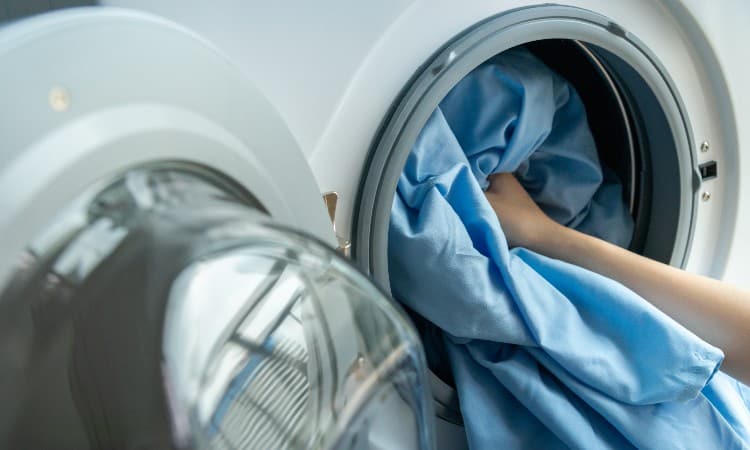
Quick Navigation
Can You Wash 100% Silk?
Yes, you can wash 100% silk. However, it isn’t as simple as it sounds. Silk is a natural fiber that can be woven into a luxury fabric. The weave of the fabric can differ depending on the end use of the material. This can be as diverse as an extremely delicate blouse to soft and decadent bed sheets.
The more delicate the weave, the easier it is for the silk fibers to be damaged by heat and water. Because of this, manufacturers of silk items always put their recommended care instructions on the garment label.
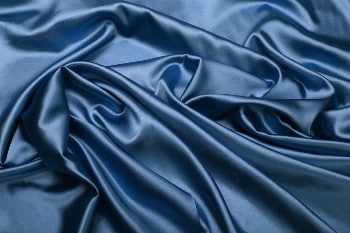 Before you get your 100% silk anywhere near water, you should always check that care label. In most cases, particularly for garment silk, manufacturers will recommend you dry clean only. The reason for this is there is less chance of damage to the fabric if you keep your silk away from moisture.
Before you get your 100% silk anywhere near water, you should always check that care label. In most cases, particularly for garment silk, manufacturers will recommend you dry clean only. The reason for this is there is less chance of damage to the fabric if you keep your silk away from moisture.
Silk contains a substance known as sericin. It’s a kind of glue that holds the silk together when it forms the cocoon around the silkworm. The main problem with sericin is that water is its nemesis.
100% silk used for garments tends to be more of a loose or delicate weave. Water can flow between the fibers causing the sericin holding them all together to release its grip. The fibers will move away from each other, pulling or tightening the weave as they go. This can make the garment look like it has shrunk.
Densely woven silk is better suited to washing. As the fibers are already part of a tight weave, there is less room for the silk fibers to move. Silk sheets and pillowcases tend to be made from a slightly tighter weave to ensure they are more durable and easier to wash. Sheets and pillowcases need regular cleaning, and constant trips to the cleaners can be both pricey and inconvenient.
Unfortunately, if water is silk’s nemesis, heat is its kryptonite. Mix the two and you have a recipe for disaster. Heat will not only quicken the destruction of sericin but also cause the colors in your silk to run.
So although it is possible to wash 100% silk, you have to be careful when doing so. Always follow the instructions on your care label. Dry clean only items should always be dry cleaned to ensure the longevity of your silk.
If you do find you have to wash 100% silk, the safest way to do so is by hand in cool or cold water. You should then allow the silk to air dry away from direct sunlight.
Can You Machine Wash Silk Sheets?
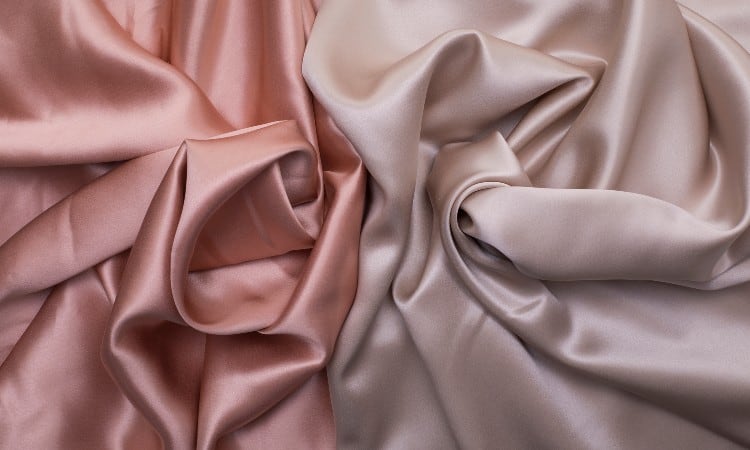
Yes, you can wash silk sheets by machine. You can also wash them by hand, although that is a little more difficult due to the size of the sheets. The one thing that you do have to keep in mind, though, silk sheets can be easily damaged by heat and water.
Whenever you are washing silk, you have to be careful. I’ve put together a step-by-step guide to washing silk sheets in a machine. Follow these tips to keep your sheets in tip-top condition.
You will need:
- Washing machine
- Mesh laundry bag
- Laundry detergent suitable for silk fabric
- Distilled white vinegar
- Bath towel
- Clothesline
Step 1
Your first step is to read the instructions on the care label. Not only will this tell you if the silk sheets can be washed, but it will also let you know the best water temperature to use.
Step 2
Put your silk sheets into a mesh laundry bag. This will cut down on the fabric getting damaged by the drum of the washing machine. Always wash silk separately from any other garment. It’s great to save water and get a lot of items washed at the same time, but silk suffers less damage when it’s by itself.
Step 3
Load the laundry bag containing the sheets into your machine and close the door. Select a delicate cycle and a cool or cold water temperature. Make sure the machine is set to a light spin, or better still, no spin.
Step 4
Add a laundry detergent suitable for silks and delicate fabrics. Studio by Tide Delicates is a good choice. So too is Heritage Park Silk & Wool Detergent. Follow the directions on the detergent bottle to find out how much to use. Remember to add distilled white vinegar to the final rinse, as this will remove any detergent residue.
Step 5
When the cycle has ended, remove the silk sheets from the machine. Take them out of the mesh bag carefully and roll them up in a bath towel. This will soak up the excess water.
Step 6
As soon as the silk has stopped dripping water, hang the sheets on an outside clothesline to dry. Make sure they are not in direct sunlight.
How to Wash Silk Sheets and Pillowcase
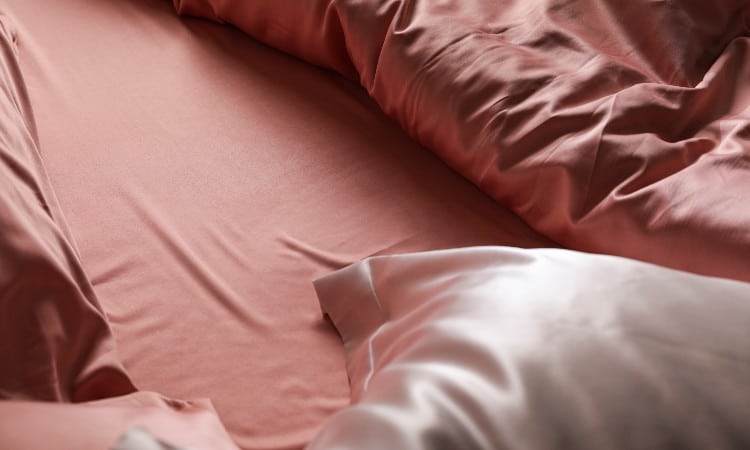
The key to washing silk sheets and a pillowcase is to make sure you do so carefully. Always check the manufacturer’s care label for the best way to clean your silk bedding. Their recommendation will be the safest and most effective way of cleaning your silk.
If your sheets and pillowcase don’t have care labels, there are some generic washing tips you can follow. These methods will ensure your silk will survive the wash cycle and look clean and fresh for years to come.
1. Make Sure Your Silk is Colorfast
One of the first things you should do before washing silk is to check it to make sure it is colorfast. Some silk will bleed color into the water, regardless of the temperature.
Do a quick color check on an inconspicuous area. If any signs of color come out in the water, don’t wash it. You have silk that is dry clean only. Take it to a professional cleaner so they can clean your silk sheets safely.
2. Use a Mesh Laundry Bag
A mesh laundry bag is a lifesaver for silk sheets, pillowcases, and silk items in general. It protects the silk by keeping the fabric in one place.
Washing machines can be rough on silk material. As the machine goes through the washing cycle, it rotates your silk sheets and pillowcase through soapy water. Paddles inside the drum move the fabric around, tossing it from one side to the other and back again.
This motion is what causes damage to silk fibers. They can get ripped, torn, or stretched out of shape by the vigorous nature of your washing machine. Putting your silk inside a mesh bag means it’s the bag taking the pounding, not your precious silk.
3. Use Cool or Cold Water
Silk and water can be a dodgy combination. As I mentioned earlier, sericin, the glue that holds silk fibers together, is water intolerant. Getting it wet can cause your silk sheets and pillowcase to shrink. Add heat and your silk bedding could disintegrate.
All that can be avoided by watching the temperature of the water you wash your silk in. Make sure it’s either cool or cold. Although it’s still water, a cold temperature is less likely to cause as much damage. Particularly if your sheets and pillowcase are made from densely woven silk.
4. Always Wash Silk Bedding Separately
It has been said that silk should be washed with other delicate items. While this has some truth in it and can be a good rule to follow, you should consider going one step further. Wash your silk bedding separately.
Other delicate items may have zippers or buttons which can snag on silk, causing pilling or rips in the fabric. Particularly, silk sheets are bulky and take up a lot of space in the washing machine. It’s too easy for the sheets to get tangled up with other items in the drum, leading to damage caused by abrasion or knotting.
Similarly, don’t be tempted to wash your silk pillowcase in with a pair of denim jeans. Pillowcases are small and can fit in with other items. Adding them to a wash with your jeans could make the difference between having a full load and one with hardly anything in it. But, jeans have zippers, rivets, buttons, and heavy-duty hems, all of which can cause irreparable damage to your silk.
5. Keep Away From Bleach
Chlorine bleach can be used to remove stains on some materials. However, in some cases, it can damage the fabric rather than cleaning the material found in garments or bedding. Silk is one of those fabrics you should keep away from chlorine bleach.
Not only will chlorine bleach attack the fibers in the silk, but it can also make them turn yellow. In the worst cases, you can watch your silk fibers dissolve before your eyes as the bleach eats them away.
The same goes for oxygen bleach. Although oxygen bleach is considered a safer alternative to chlorine bleach for many fabrics, there are still some materials it can’t be used on. Wool, leather, wood, and silk are all easily damaged by oxygen bleach.
6. Don’t Use Your Iron
Although many irons have a delicate setting or even a silk setting, ironing silk sheets or pillowcases isn’t recommended. The reason is heat. Too much heat from an iron, even on its coolest setting, can damage silk fibers.
Silk usually wrinkles after washing, but the great thing about silk sheets is the wrinkles will disappear by themselves. The same is true for pillowcases. So there’s no need to get the iron out for silk bedding.
If ironing is your thing, you can iron your silk as long as you are extra careful. Only use the coolest setting and iron for the shortest time possible. Using a pressing cloth can help minimize any damage. But, be aware that even the coolest setting can get too hot.
How to Wash Silk Pillowcase by Hand
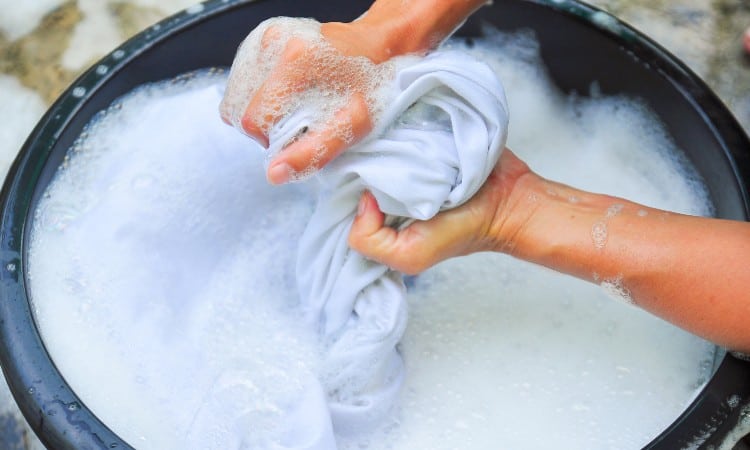
You might find it easier to wash silk pillowcases in the washing machine, but it is possible to wash them by hand. Depending on the weave and silk content, sometimes washing them by hand is the safest way.
First of all, you need to check if your silk is washable. Turn the pillowcase inside out and check the care label. You’re good to go if you can see a little diagram of a hand in a bowl of water. If you don’t have a care label, do a spot check to see if your silk pillowcase is colorfast. Any color in the water indicates it isn’t and should be taken to a dry cleaner.
If you have stains on your pillowcase, pretreat them with a silk laundry detergent before washing. Add the detergent to the stain and allow it to soak for about 15 minutes.
You will need:
- Sink, basin, or tub
- Laundry detergent suitable for silk-based
- Distilled white vinegar
- Bath towel
- Clothesline
Step 1
Fill your sink, basin, or tub with enough cool water to completely cover the pillowcase. Add some laundry detergent that is suitable for use with silk. Check the detergent bottle for the correct dosage.
Step 2
Swish the water and detergent, so they mix. Put your silk pillowcase into the water and gently swirl it around. Be careful not to twist the fabric. Use a back and forth motion and be sure to use a light touch.
Step 3
Drain the water. Refill your sink, basin, or tub with fresh water. Only this time, use cold. This is the rinsing phase. Using the same back and forth motion, swirl the silk pillowcase around. Don’t be tempted to twist or rub.
Step 4
Keep rinsing in fresh cold water until all the suds have gone. Add a splash of vinegar to the final rinse to make sure all the soap has been removed.
Step 5
Remove the pillowcase from the water and place it on a clean bath towel. Roll it up, so the towel soaks up the excess water. If the towel gets too wet, replace it with another one and keep the silk rolled up until it no longer drips water.
Step 6
Allow to air dry by either hanging outside on a clothesline or laying the pillowcase on a flat surface. Make sure the pillowcase is away from direct sunlight.
How Often Should You Wash Silk Sheets and Pillowcases?
You should wash your silk sheets and pillowcases as often as if they were made from cotton. Bedding picks up old skin cells and sweat every night you sleep on it. It’s important to keep your sheets and pillowcases as clean as possible to ensure your skin stays healthy.
At the very least, you should wash your silk sheets and pillowcases every 6 to ten days. This will ensure that any residue from skin and hair care products, bits of dead skin, and body fluids are removed.
Washing your silk infrequently can cause issues. Not just for you and your skin but also the silk fibers in your sheets and pillowcases. The longer products and other debris stay on your bedding, the more likely they will stain your silk. This can make washing your sheets a lot harder.
For pillowcases, the stains can be more pronounced. Hair can get greasy. This rubs off onto the pillowcase and can spread out, creating a huge soiled patch. Ensuring they are washed on time will prevent the stains from building up and keep your silk fresher for longer.
Generally, if you suffer from oily or acne-prone skin, you should wash your silk sheets and pillowcases more often. If you have a cold or other viral illness, wash your bedding as soon as you feel better.
What Detergent Is Best for Silk Sheets?
The best detergent for silk sheets is one specifically designed for delicate materials. However, not all delicate textiles need the same care as silk fabric. So always check the label on the detergent to make sure it has been formulated for silk.
You’ll find that a detergent suitable for silk is usually also suitable for wool. Both fibers are animal-based, so they have similar needs when caring for them. If you find your brand of delicate detergent is focused on wool fabrics, check the small print on the back. You might find it mentions silk.
You need to be absolutely sure that there is no bleach, enzymes, or phosphates in the washing detergent you use on your silk sheets.
The following products are safe to use on silk sheets, pillowcases, and other silk items, regardless of whether they are 100% silk or silk blends.
Woolite Delicates Hypoallergenic Liquid Laundry Detergent
 Woolite is probably one of the better-known brands of delicate detergents. Not only is this product safe to use on wool, cashmere, satin, and polyester, but it’s also OK to use on silk. Better still, being hypoallergenic, it’s kind to your skin too! This is great news if you hand wash your silk pillowcases or sheets.
Woolite is probably one of the better-known brands of delicate detergents. Not only is this product safe to use on wool, cashmere, satin, and polyester, but it’s also OK to use on silk. Better still, being hypoallergenic, it’s kind to your skin too! This is great news if you hand wash your silk pillowcases or sheets.
Available from Amazon and your local big box store, Woolite is readily available and reasonably priced.
The unique Woolite formula prevents fading, shrinking, and stretching. Keeping your silk sheets looking fresh and new for longer.
Studio by Tide Delicates
 The special formula found in Studio by Tide Delicates keeps stray fabric fibers smooth and in check.
The special formula found in Studio by Tide Delicates keeps stray fabric fibers smooth and in check.
Specifically designed for silk, lace, and wool, this product protects against pilling and fading.
Suitable for standard and HE washing machines, this liquid detergent protects your silk even in the coldest setting. Free from parabens, phthalates, and phosphates, it’s safe to use on silk sheets and wool blankets.
Heritage Park Silk & Wool Detergent
 Hypoallergenic and dermatologist tested, Heritage Park Silk & Wool Detergent is pH neutral and enzyme-free.
Hypoallergenic and dermatologist tested, Heritage Park Silk & Wool Detergent is pH neutral and enzyme-free.
The product is made with plant-based ingredients and specially formulated for silk and wool. It’s even safe to use with fur.
There are no brighteners, fragrances, dyes, bleach, or sulfates contained in the product, making it safe for your fabrics, your family, and the local ecology.
Can you Dry a Silk Pillowcase in the Dryer?
Drying a silk pillowcase in a dryer is not recommended. Silk is heat intolerant. Even on a low setting, dryers can get too hot for the delicate silk fibers.
If you are in a rush to get your silk pillowcase dry, you can use the “air” setting on your dryer. However, this should only be for the shortest time possible. Silk and dryers are not a good match.
It is not advisable to dry your silk pillowcase or sheets in direct sunlight either. Sunlight has the same damaging properties as your dryer in that it can get too hot. It is also a natural bleaching agent and can cause the colors in your silk to fade.
The best and safest way to dry silk sheets and pillowcases is to air dry them. You can either use an internal drying rack or a clothesline outside. Make sure the silk is away from heat sources like radiators, fires, or sunlight. Too much heat will cause silk to shrink.
Conclusion
Washing silk sheets and a pillowcase is easier than you think. All you need to do is take a little extra care in the washroom. Always use a detergent designed for delicate fabrics like silk. This will keep your sheets and pillowcases fresh, clean, and vibrant for years to come.
Let me know in the comments if you liked the article. Has it encouraged you to buy some luxurious silk bedding? Do you already have silk sheets? How do you care for them?